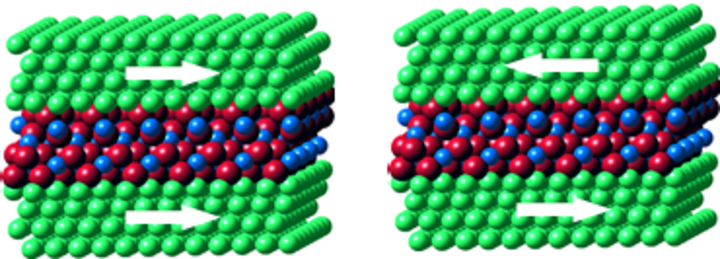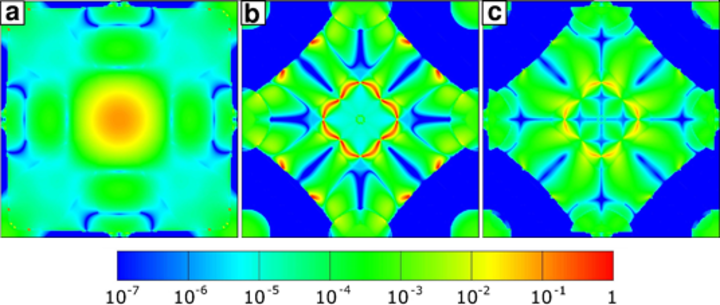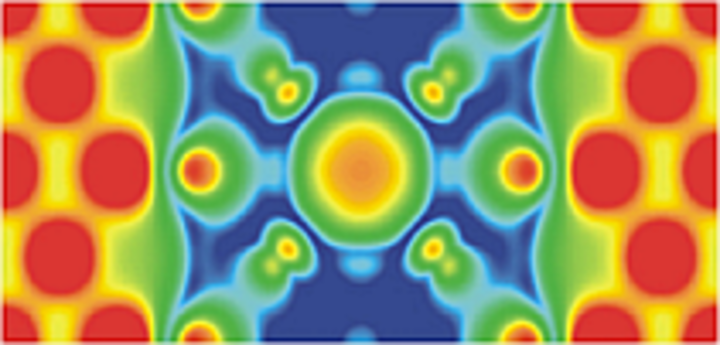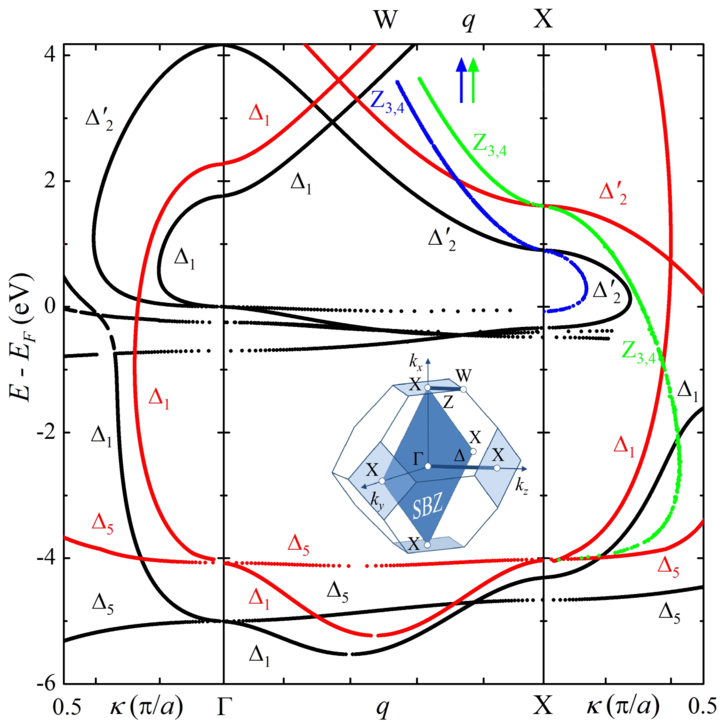Spin-dependent tunneling (SDT) is an imbalance in the electric current carried by up- and down-spin electrons tunneling from a ferromagnet through an insulating barrier. A related phenomenon, tunneling magnetoresistance (TMR), is a change in resistance of a magnetic tunnel junction (MTJ) when the magnetization of the two ferromagnetic layers changes its alignment.
These phenomena are interesting for applications in magnetic sensor and storage technologies. Our first-principles calculations have predicted a number of important physical properties of MTJ controlling TMR. In particular, we emphasized a decisive role of interfaces in MTJs and showed that the interface atomic and electronic structure is largely responsible for their spin-dependent transport characteristics. Interface resonant states may significantly contribute to the functional properties of MTJs and even alter the spin polarization of tunneling electrons. Electron scattering by oxygen vacancies in Fe/MgO/Fe tunnel junctions is detrimental for TMR and thus improving the quality of the MgO barrier is important for the enhanced performance of these junctions. Resonant tunneling via localized states in the barrier can reverse TMR, as has been confirmed in experiments performed on electro-deposited Ni/NiO/Co nanojunctions.
Our fully relativistic first-principles calculations applied to the Fe(001) surface demonstrate that resonant surface states may produce sizable tunneling anisotropic magnetoresistance (TAMR) in MTJs with a single magnetic electrode. The effect is driven by the spin-orbit coupling that shifts the resonant surface band via the Rashba effect when the magnetization direction changes. In collaboration with experimentalists we showed that the anomalous angular dependence of TAMR in MTJs can be explained by interface resonant states. We also predicted the effect of tip resonances on TAMR in ferromagnetic metal break-junctions.
References
- X. L. Li, J.-T. Lü, J. Zhang, Y. R. Su, and E. Y. Tsymbal, “Spin-dependent transport in van der Waals magnetic tunnel junctions with Fe3GeTe2 electrodes,” Nano Letters 19, 5133-5139 (2019).
- P. Lukashev, A. Wysocki, J. P. Velev, M. van Schilfgaarde, S. S. Jaswal, K. D. Belashchenko, and E. Y. Tsymbal, “Spin filtering with EuO: Insight from a complex band structure,” Phys. Rev. B 85, 224414 (2012).
- E. Y. Tsymbal, K. D. Belashchenko, J. Velev, S. S. Jaswal, M. van Schilfgaarde, I. I. Oleynik, and D. A. Stewart, "Interface effects in spin-dependent tunneling," Prog. Mater. Science 52, 401 (2007).
- A. N. Chantis, K. D. Belashchenko, D. L. Smith, E. Y. Tsymbal, M. van Schilfgaarde, and R. C. Albers, "Reversal of spin polarization in Fe/GaAs (001) interface driven by resonant surface states: First-principles calculations," Phys. Rev. Lett. 99, 196603 (2007).
- L. Gao, X. Jiang, S. Yang, J. D. Burton, E. Y. Tsymbal, and S. S. P. Parkin, "Bias voltage dependence of tunneling anisotropic magnetoresistance in magnetic tunnel junctions with MgO and Al2O3 tunnel barriers," Phys. Rev. Lett. 99, 226602 (2007).
- A. N. Chantis, K. D. Belashchenko, E. Y. Tsymbal, and M. van Schilfgaarde, "Tunneling anisotropic magnetoresistance driven by resonant surface states: First-principles calculations on a Fe(001) surface," Phys. Rev. Lett. 98, 046601 (2007).
- J. Velev, K. D. Belashchenko, S. S. Jaswal, and E. Y. Tsymbal, "Effect of O vacancies on spin-dependent tunneling in Fe/MgO/Fe magnetic tunnel junctions," Appl. Phys. Lett. 90, 072502 (2007).
- J. Velev, K. D. Belashchenko, D. Stewart, M. van Schilfgaarde, S. S. Jaswal, and E. Y. Tsymbal, "Negative spin polarization and large tunneling magnetoresistance in epitaxial Co/SrTiO3/Co magnetic tunnel junctions," Phys. Rev. Lett. 95, 216601 (2005).
- K. D. Belashchenko, J. Velev, and E. Y. Tsymbal, "Effect of interface states on spin-dependent tunneling in Fe/MgO/Fe tunnel junctions," Phys. Rev. B 72, R140404 (2005).
- K. D. Belashchenko, E. Y. Tsymbal, M. van Schilfgaarde, D. Stewart, I. I. Oleinik, and S. S. Jaswal, "Effect of interface bonding on spin-dependent tunneling from the oxidized Co surface," Phys. Rev. B 69, 174408 (2004).
- E. Y. Tsymbal, A. Sokolov, I. F. Sabirianov, and B. Doudin, "Resonant inversion of tunneling magnetoresistance," Phys. Rev. Lett. 90, 186602 (2003).
- E. Y. Tsymbal, O. N. Mryasov, and P. R. LeClair, Topical Review: "Spin-dependent tunneling in magnetic tunnel junctions," J. Phys.: Condens. Matter 15, R109 (2003).

Magnetic tunnel junction with ferromagnetic electrodes aligned parallel and antiparallel.

Transmission coefficient resolved in the 2D Brillouin zone for Fe/MgO/Fe magnetic tunnel junction for majority- (a) and minority- (b) spin electrons for parallel and antiparallel (c) magnetization.

Charge density in a Fe/MgO/Fe tunnel junction which contains O vacancy.

Complex band structure of EuO which could serve as a spin filtering barrier in magnetic tunnel junctions.